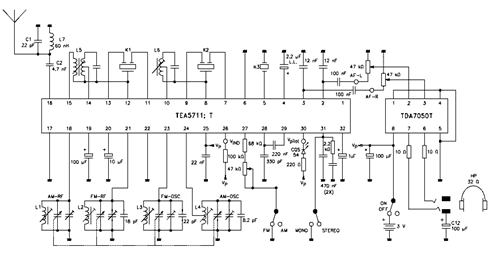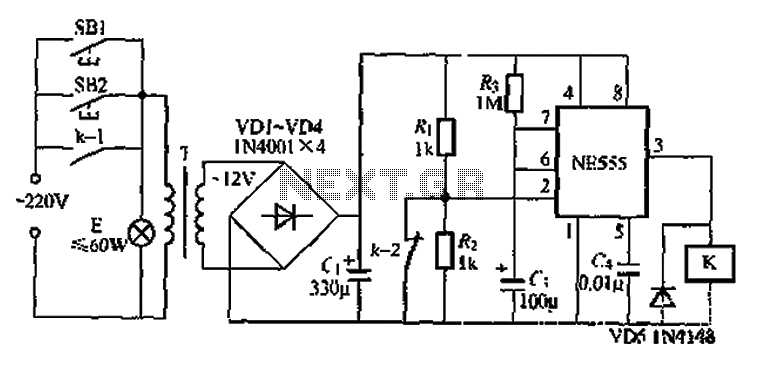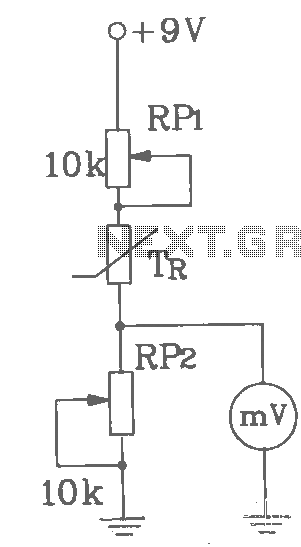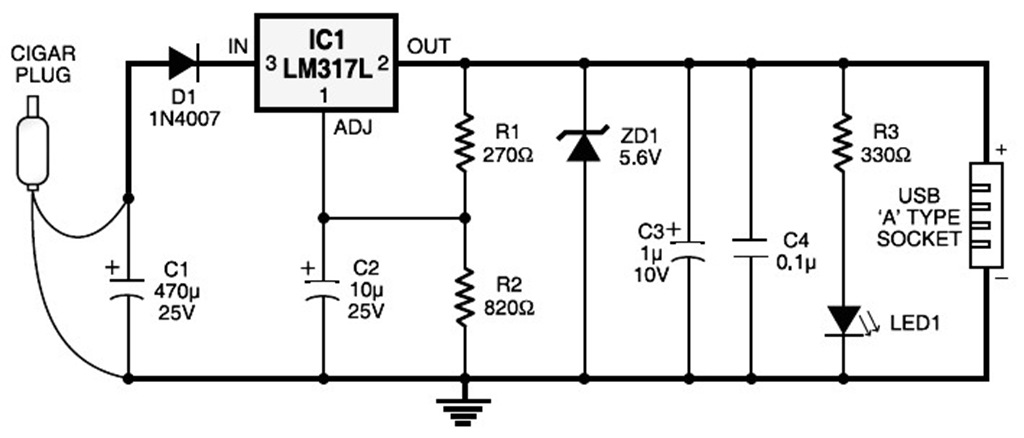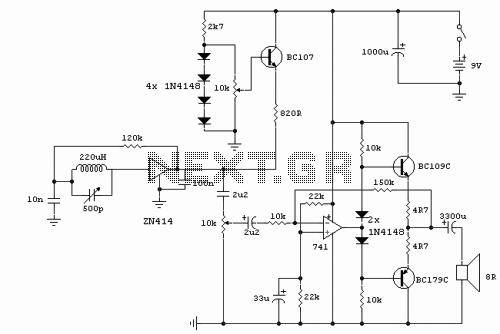
WIEN BRIDGE OSCILLATOR CIRCUIT
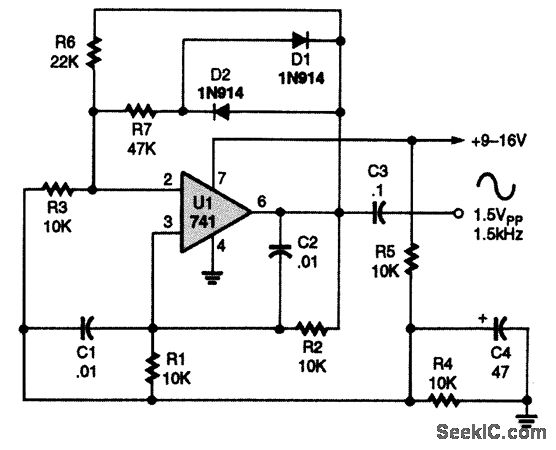
A 741 operational amplifier is configured within a Wien-bridge audio sine-wave oscillator circuit. The components C1, C2, R1, and R2 are responsible for determining the operating frequency of the circuit. By utilizing NPO capacitors and metal-film resistors, the oscillator achieves a frequency stability suitable for tone-control applications. This fixed-frequency oscillator can be modified into a tunable oscillator by replacing R1 and R2 with a dual-gang linear potentiometer. By selecting different matched values for C1 and C2, various frequency ranges can be achieved; larger capacitance values yield lower frequencies, while smaller values result in higher frequencies.
The Wien-bridge oscillator is a type of electronic oscillator that generates sine waves. In this configuration, the 741 op-amp serves as the active gain element, providing the necessary amplification to sustain oscillations. The circuit's feedback loop is formed by the resistors R1 and R2, and the capacitors C1 and C2, which create a frequency-selective network.
The frequency of oscillation, \( f \), can be determined through the formula:
\[
f = \frac{1}{2\pi R \sqrt{C1 \cdot C2}}
\]
where \( R \) is the equivalent resistance, which, in the case of a dual-gang potentiometer, can be adjusted to vary the resistance in the circuit. The values of C1 and C2 must be matched to ensure stable oscillation.
NPO (Negative Temperature Coefficient) capacitors are chosen for their minimal drift with temperature changes, which contributes to the overall stability of the oscillator. Metal-film resistors are selected for their low noise and high precision, further enhancing the performance of the circuit in audio applications.
To convert this fixed-frequency oscillator into a tunable version, the dual-gang linear potentiometer allows for simultaneous adjustment of both R1 and R2, enabling the user to fine-tune the frequency output. This flexibility makes the circuit suitable for a wide range of audio applications, including synthesizers, tone generators, and other audio processing devices.
When selecting capacitors C1 and C2, it is important to consider the desired frequency range. Larger capacitance values will lower the frequency of oscillation, while smaller capacitance values will increase the frequency. This tunability can be particularly useful in applications where precise frequency control is required, such as in musical instrument design or audio testing equipment.
Overall, the Wien-bridge oscillator utilizing a 741 op-amp is a robust solution for generating stable sine wave signals, with the potential for customization to meet specific frequency requirements.A 741 op amp is connected to a Wien-bridge, audio-sine-wave oscillator configuration, with C1, C2, R1, and R2 determining the circuit`s operating frequency. With the use of NPO capacitors and metal-film resistors, the oscillator`s frequency is stable enough for use in tone-control applications.
The fixed-frequency oscillator shown can easily be co nverted into a tunable oscillator by substituting a dual-gang linear potentiometer for R1 and R2. Different frequency ranges can be covered by using other matched values for C1 and C2. Larger values produce lower frequencies, and vice versa for small values. 🔗 External reference
The Wien-bridge oscillator is a type of electronic oscillator that generates sine waves. In this configuration, the 741 op-amp serves as the active gain element, providing the necessary amplification to sustain oscillations. The circuit's feedback loop is formed by the resistors R1 and R2, and the capacitors C1 and C2, which create a frequency-selective network.
The frequency of oscillation, \( f \), can be determined through the formula:
\[
f = \frac{1}{2\pi R \sqrt{C1 \cdot C2}}
\]
where \( R \) is the equivalent resistance, which, in the case of a dual-gang potentiometer, can be adjusted to vary the resistance in the circuit. The values of C1 and C2 must be matched to ensure stable oscillation.
NPO (Negative Temperature Coefficient) capacitors are chosen for their minimal drift with temperature changes, which contributes to the overall stability of the oscillator. Metal-film resistors are selected for their low noise and high precision, further enhancing the performance of the circuit in audio applications.
To convert this fixed-frequency oscillator into a tunable version, the dual-gang linear potentiometer allows for simultaneous adjustment of both R1 and R2, enabling the user to fine-tune the frequency output. This flexibility makes the circuit suitable for a wide range of audio applications, including synthesizers, tone generators, and other audio processing devices.
When selecting capacitors C1 and C2, it is important to consider the desired frequency range. Larger capacitance values will lower the frequency of oscillation, while smaller capacitance values will increase the frequency. This tunability can be particularly useful in applications where precise frequency control is required, such as in musical instrument design or audio testing equipment.
Overall, the Wien-bridge oscillator utilizing a 741 op-amp is a robust solution for generating stable sine wave signals, with the potential for customization to meet specific frequency requirements.A 741 op amp is connected to a Wien-bridge, audio-sine-wave oscillator configuration, with C1, C2, R1, and R2 determining the circuit`s operating frequency. With the use of NPO capacitors and metal-film resistors, the oscillator`s frequency is stable enough for use in tone-control applications.
The fixed-frequency oscillator shown can easily be co nverted into a tunable oscillator by substituting a dual-gang linear potentiometer for R1 and R2. Different frequency ranges can be covered by using other matched values for C1 and C2. Larger values produce lower frequencies, and vice versa for small values. 🔗 External reference
